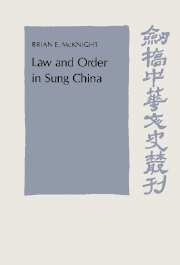Book contents
- Frontmatter
- Contents
- List of figures, maps, and tables
- Preface
- List of abbreviations
- 1 Introduction
- 2 The historical context
- 3 Crimes and criminals
- 4 Informal and semiformal agencies of law enforcement
- 5 Formal civil agencies of law enforcement
- 6 The role of the military in law enforcement
- 7 Supervision of law enforcement – the role of the intendants
- 8 Personnel selection
- 9 Urban crime and urban security
- 10 The Sung penal system
- 11 Jails and jailers in the Sung
- 12 Penal registration
- 13 The death penalty
- 14 Modifications of penalties
- 15 Conclusion
- Glossary
- Bibliography
- Index
11 - Jails and jailers in the Sung
Published online by Cambridge University Press: 23 December 2009
- Frontmatter
- Contents
- List of figures, maps, and tables
- Preface
- List of abbreviations
- 1 Introduction
- 2 The historical context
- 3 Crimes and criminals
- 4 Informal and semiformal agencies of law enforcement
- 5 Formal civil agencies of law enforcement
- 6 The role of the military in law enforcement
- 7 Supervision of law enforcement – the role of the intendants
- 8 Personnel selection
- 9 Urban crime and urban security
- 10 The Sung penal system
- 11 Jails and jailers in the Sung
- 12 Penal registration
- 13 The death penalty
- 14 Modifications of penalties
- 15 Conclusion
- Glossary
- Bibliography
- Index
Summary
Introduction – imprisonment and punishment
The policies governing imprisonment in the Sung dynasty reflect a mixture of motives determined by the special uses of jails, by current views of the nature of criminals, and by some general characteristics of the traditional Chinese state. Jails were used primarily for those awaiting either trial or punishment. They might also hold witnesses or convicts in transport. Imprisonment, however, was not thought of as a punishment in itself. The widespread conviction that most people, including most criminals, were capable of acting properly conflicted with a tendency to dismiss those in jail as bad people who deserved their fate. After all, their being in jail was proof of something. In his book of advice to local officials, the thoughtful and compassionate Ch'ing magistrate Huang Liu-hung comments: “It is all too easy to say that criminals are wicked people who deserve nothing except death. Alas, Heaven creates tigers, leopards, wolves, wasps, and lizards, and they are all endowed with lives. How can human beings be deprived of an opportunity to live?” Concern for the lives of convicted and suspected criminals was part of a wider human concern. Furthermore, not all those held in jails were in fact either convicted or suspected criminals. Under premodern conditions (as indeed is still all too true under modern conditions) the difficulties of getting witnesses to the courtroom at the proper time are very serious. The traditional Chinese answer was to hold certain witnesses in jail.
- Type
- Chapter
- Information
- Law and Order in Sung China , pp. 353 - 384Publisher: Cambridge University PressPrint publication year: 1992



